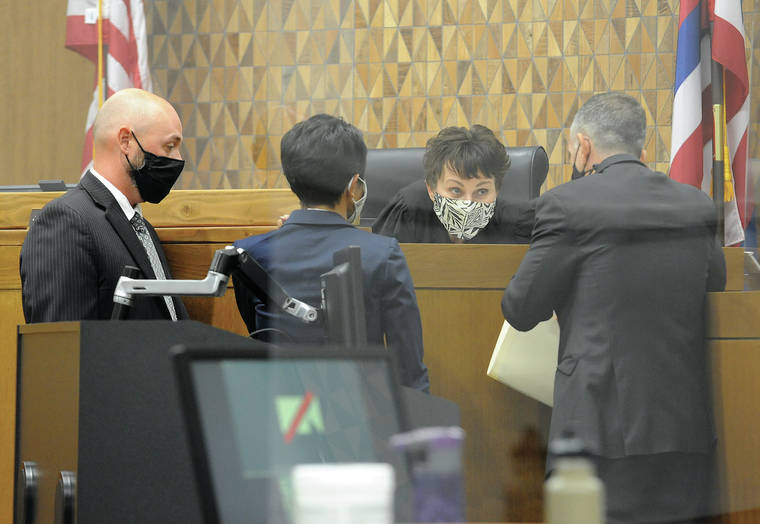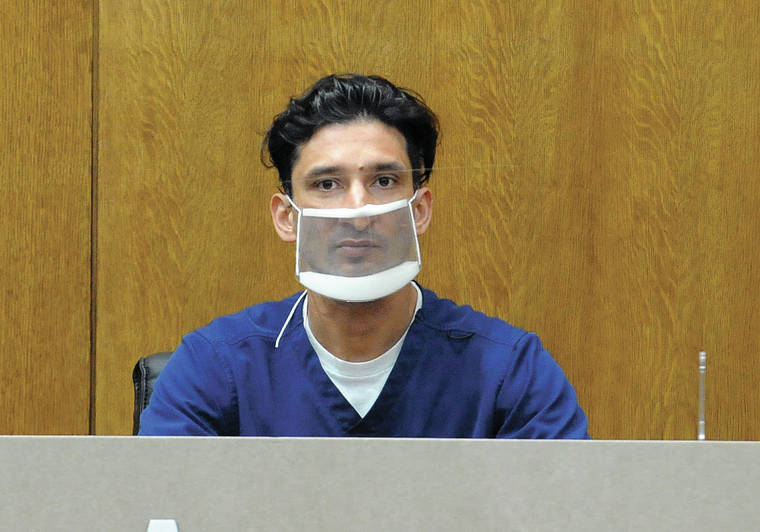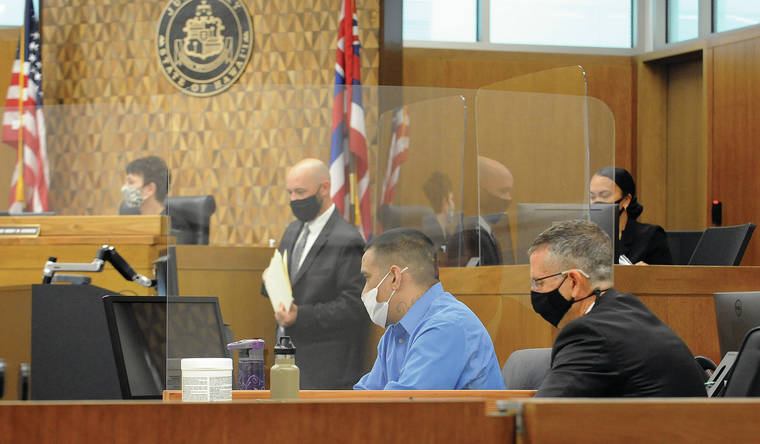Closing arguments are scheduled for today in the trial of a Kailua-Kona man accused of attempted murder of a police officer fronting a Kailua Village restaurant in 2019.
The jury trial of Shannon Kaleolani Ke continued for a fourth day Thursday, starting first without the jury present to address admissibility of evidence and the qualifications of a witness.
Ke is charged with first-degree attempted murder with the enhancement of a hate crime, disorderly conduct, first-degree assault, two counts of first-degree assault on law enforcement officer Randall Hancock and resisting arrest in connection with the 2019 incident on the shoreline fronting Huggo’s On The Rocks.
At issue was the anticipated testimony from Dr. Zain Vally-Mahomed, a pain management and occupational medicine specialist who treated Hancock after the March 26, 2019, incident. Deputy Public Defender James Greenberg argued the mention of traumatic brain injury, or frontal lobe damage, should not be allowed in Vally-Mahomed’s testimony because he is not a neurologist, therefore unable to make the diagnosis.
He said the emergency room report on the day of the incident indicated no significant injuries, and there was no neurologist report indicating frontal lobe damage.
“I am worried about this,” Greenberg said. “This is a huge issue. This is affecting Mr. Ke’s defense. The MRI report is clear. There is no brain damage. I’m concerned frontal lobe damage will come into the trial willy-nilly.”
Vally-Mahomed took the stand without jurors present and testified Hancock’s condition was deteriorating. He was falling down and suffering loss of consciousness, which is why the doctor sent the officer to a neurologist for a consultation. Hancock was diagnosed with a seizure disorder, and the source of seizures is in the brain. He also stated the seizures have improved with medication. As a result of the consultation, Vally-Mahomed diagnosed Hancock with cervical and lumbar herniated and torn disks, post concussion syndrome and a traumatic brain injury.
Under questioning by Greenberg, the doctor said he did not have a neurology report to back up the diagnosis.
After hearing testimony, Kona Circuit Court Judge Wendy DeWeese ruled she was not going to allow Vally-Mahomed to testify regarding the brain injury.
With the jury back in the courtroom, Vally-Mahomed testified about Hancock’s spinal injuries, seizures and syncope (fainting).
“He will not be able to return to work,” he said.
Physical Therapist Noelani Vargas testified the primary focus of therapy for Hancock was in his neck.
“Initially, we didn’t see any red flags, but on April 17, 2019, at the end of his treatment he got up and fainted. He lost consciousness,” she said. That was when she recommended a referral to a neurologist.
The final witness to take the stand was Hawaii Police Department Lt. Jerome Manuel, lead investigator in the case.
A video of Ke providing his statement to Manuel at the Kona Police Station was played for the jury.
In the video, Ke was heard telling the detective he was just practicing his Hawaiian cultural rights.
“I was pissed off I couldn’t have a cigarette on the beach,” Ke said. So he sat down on the rocks and had a drink.
When Hancock came, Ke said the officer grabbed him by the wrist and when he pulled his hand away, they both fell into the water. Ke denied ever hitting Hancock or trying to drown him.
“I was practicing my cultural rights,” he repeated. “I can talk as loud as I like.”
When questioned by Greenberg, Manuel stated Hancock’s statement never said he swung the liquor bottle at him, only that he believed Ke was going to swing the bottle. Greenberg also questioned the detective if Hancock ever told him he tried to use a Taser on Ke, to which Manuel replied “no.”
During rebuttal, Deputy Prosecuting Attorney Chase Murray asked Manuel “If you were in a life-threatening situation would you use a Taser if you were being assaulted?”
“Yes,” Manuel replied.
The prosecution rested its case and the jury was dismissed for the day when a motion for acquittal was heard.
Greenberg argued the case was overcharged and there was no attempt to murder Hancock.
Murray argued there was more than enough evidence to support the charges.
DeWeese denied Greenberg’s motion, stating there was sufficient evidence to support the charges.
If convicted of the charges, Ke faces life in prison without the possibility of parole.











